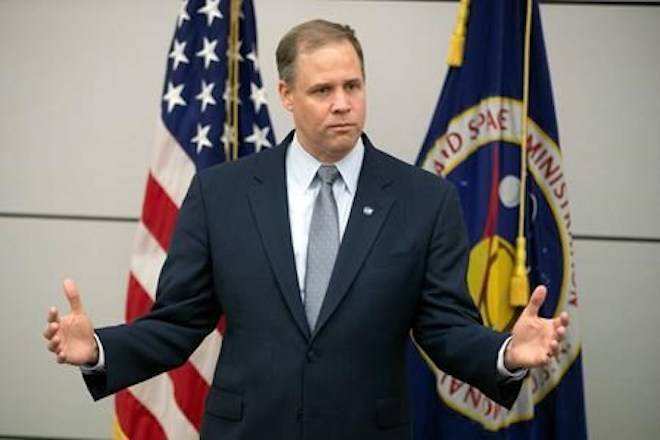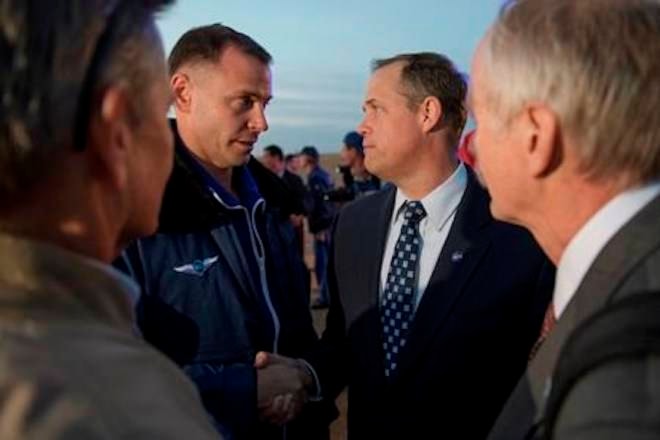U.S. astronaut Nick Hague thanked Russian rescue teams Friday for quickly reaching him and his Russian crewmate after an aborted launch that led to their emergency landing in the barren steppes of Kazakhstan.
The Soyuz rocket that Hague and Russian cosmonaut Alexei Ovchinin were heading off in to the International Space Station failed two minutes after Thursday’s launch, releasing a rescue capsule that carried them back to Earth.
“Thank you all for your support & heartfelt prayers,” Hague tweeted from Star City, the Russian space training centre outside Moscow where the two astronauts arrived Friday. “Operational teams were outstanding in ensuring our safety & returning us to family & friends. Working with our international partners, I’m confident that we will find a path forward & continue the achievements of @Space_Station.”
U.S. and Russian space officials said the astronauts were in good condition even though they experienced a gravitational force that was six-to-seven times more than is felt on Earth when their capsule went into a steep, harrowing fall back to the ground.
NASA chief Jim Bridenstine told reporters in Moscow on Friday that the Soyuz emergency rescue system worked flawlessly.
“I just want to say how grateful we are as a country, the United States, for our Russian partners,” he said. “That’s an amazing capability and we can’t understate how important it is.”
Dmitry Rogozin, head of Russia’s Roscosmos space agency, promised that Hague and Ovchinin will be given another chance soon to work on the orbiting space outpost.
“The boys will certainly fly their mission,” Rogozin tweeted, posting a picture in which he sat with the two astronauts aboard a Moscow-bound plane. “We plan that they will fly in the spring.”
Russian space officials said Hague and Rogozin will spend a couple of days at Star City undergoing routine medical checks.
“They are in good health and don’t need any medical assistance,” said Vyacheslav Rogozhnikov, a deputy chief of the Russian Federal Medical and Biological Agency.
Related: US, Russian astronauts safe after emergency landing
Related: Astronaut drops in on Kraftwerk gig, plays duet from space
The aborted mission dealt another blow to the troubled Russian space program, which currently serves as the only way to deliver astronauts to the space station.
Sergei Krikalyov, the head of Roscosmos’ manned programs, said the launch went awry after one of the rocket’s four boosters failed to jettison about two minutes into the flight, damaging the main stage and triggering the emergency landing. He said a panel of experts is looking into the specific reason that prevented the booster’s separation.
“We will need to look and analyze the specific cause — whether it was a cable, a pyro or a nut,” he said. “We need more data.”
Krikalyov said all Soyuz launches have been suspended pending the investigation. Preliminary findings are expected later this month, Krikalyov said, adding that Roscosmos hopes to be able to sort out the problem and perform the next Soyuz launch in December.
The current space station crew of an American, a Russian and a German was scheduled to return to Earth in December after a six-month mission. It wasn’t immediately clear if their stint in orbit might need to be extended due to Thursday’s failed launch.
A Soyuz capsule attached to the station which they use to ride back to Earth is designed for a 200-day mission, meaning that their stay in orbit could only be extended briefly.
“We don’t have an opportunity to extend it for a long time,” Krikalyov said.
NASA said flight controllers could operate the space station without anyone on board if the Russian rockets remain grounded. But NASA’s Bridenstine voiced hope that the problem that aborted the launch could be solved quickly and the next Soyuz launch may take place in December.
“I have no anticipation right now that the launch in December for the next crew will be delayed,” he said.
Krikalyov emphasized that Roscosmos will do its best not to leave the space station unoccupied.
“The station could fly in an unmanned mode, but will do all we can to avoid it,” he said.
While the Russian program has been dogged by a string of problems with unmanned launches in recent years, Thursday was the first manned failure since September 1983, when a Soyuz exploded on the launch pad.
Roscosmos pledged to fully share all relevant information on the failed launch with NASA, which pays up to $82 million per Soyuz seat to the space station.
Bridenstine hailed the U.S.-Russian co-operation in space, voicing hope that tensions between Moscow and Washington in other areas wouldn’t affect that relationship.
“We can both do more in space together than we can ever do alone,” Bridenstine said. “When it comes to space and exploration and discovery and science, our two nations have always kept those activities separate from the disputes that we have terrestrially. I anticipate that this relationship will stay strong.”
___
Nataliya Vasilyeva in Moscow contributed to this report.
Vladimir Isachenkov, The Associated Press
Like us on Facebook and follow us on Twitter.

